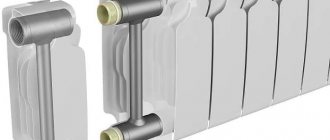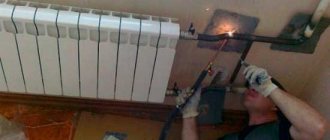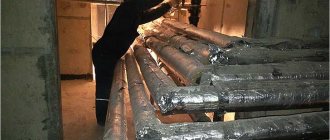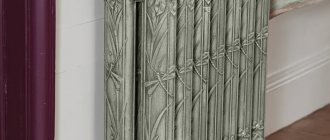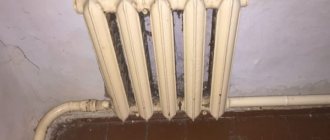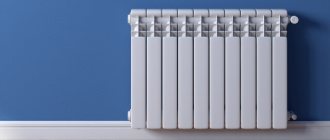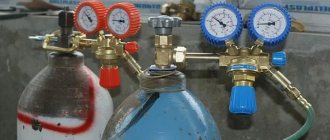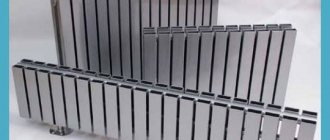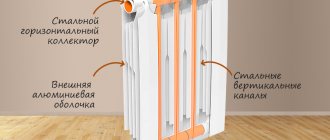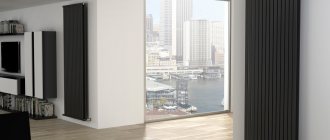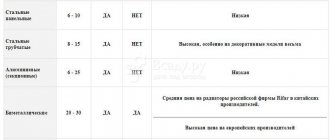Dismantling old plumbing and communications during a move or renovation is common. However, such a component of the house as cast iron batteries is not always replaced in such cases. The reason is the established opinion that old cast iron batteries are good and nothing can be better than them. But is this really so? What are their advantages and disadvantages, and is it worth replacing cast iron batteries with modern ones? For those who are puzzled by this issue, the Santekhbomb store has prepared useful material that will help you make the best decision.
pros
- Reliability and durability. Cast iron is unpretentious to the coolant; it will not be damaged even by large fractions or aggressive chemical impurities, often contained in water from Russian thermal power plants. The maximum permissible coolant temperature reaches 130-150 degrees. With regular cleaning, the service life of such a battery can be decades.
- High heat capacity and thermal inertia. Such batteries give off heat for a long time, which after switching off can remain in them up to one third of the original volume. However, this same feature of the material is also its disadvantage - more about this in the corresponding section.
How to rinse at home
In country houses, the heating system often loses its efficiency. This happens through poor heat transfer, as well as as a result of debris settling on the walls of the batteries. The coolant heated to a high temperature affects the inside of the radiators, where scale and rust settle. The presence of blockages leads to poor heating of the building.
The main reasons for flushing batteries are:
- Uneven heating of the radiator over the entire plane, when the upper part of the sections is hot, but the bottom of the tank remains cold;
- Warming up the heating system to the required temperature takes longer than usual;
- Increased fuel consumption.
To independently flush heating devices, aluminum or cast iron radiators, you need to drain the water and unscrew the radiator from the system. Removing blockages or flushing occurs using clean water with the addition of acetic acid, special cleaning agents or caustic soda.
Battery before and after washing
It is advisable to carry out the work in the bathroom to prevent liquid from spilling onto the floor. At the same time, a mesh is installed in the bathroom drain hole to collect large contaminants. Pre-placed rags will help prevent damage to the container's coating.
At the initial stage of work in cast iron radiators, all plugs are unscrewed, and water heated to a boil is poured into the resulting holes. Next, shake out the heating device and drain the liquid and debris.
Next time, water with the selected cleaning agent is poured into the radiator. After this, close all the plugs, knock on the device with a wooden hammer, shake it and pour out the water. Similar operations are carried out until clean liquid flows from the holes.
Minuses
- Heavy weight. Cast iron is a very heavy metal; the weight of one section of a cast iron radiator can reach several kilograms. On average, this is 2-3 times more than the weight of a bimetallic battery section, and 4-6 times more than the weight of an aluminum radiator. .
- Price. One section of a cast iron radiator is noticeably more expensive than a section of a bimetallic or aluminum battery that is similar in size and heat transfer.
- Impossibility of installation in a system with automatic adjustment. The design features of the battery and the properties of the metal will prevent the sensors from receiving up-to-date information about the temperature of the coolant and surface. When choosing which heating radiators are best to install in an apartment, be sure to take this nuance into account.
- Low efficiency. Due to thermal inertia, heating a square meter of area will require much more energy and coolant than in the case of other types of batteries. This may be completely unimportant if your heating is centralized and you pay based on the square footage of the house. But if you have a gas boiler, you will have to spend more of your own money, and it will be spent mainly on heating the battery itself, and not on increasing the temperature in the room.
- Unaesthetic appearance. Note that this only applies to old batteries, but if you have just such ones, they are unlikely to fit harmoniously into a modern environment. In this regard, cast iron batteries of the new type are no different from their bimetallic or aluminum “brothers” - they look modern and stylish and will fit perfectly into the interior of any apartment.
Life time
The first mention of a cast iron battery dates back to 1857, when the famous Russian engineer Franz Sangalli made the first cast iron radiator from a piece of pipe. A special feature of his invention were protruding fins, which were used to remove accumulated heat. After some time, the appearance of the cast iron radiator changed, it took on the appearance of an accordion.
For a long time, heating devices made of cast iron were the main ones in civil and industrial buildings in Russia. One of the advantages of cast iron radiators is their long service life. According to experts, such a battery can be used for 50 years, but this requires periodic maintenance of the system. It consists of washing the sections and replacing the gaskets between the blocks.
New cast iron batteries
If the advantages of a cast iron battery outweigh its disadvantages for you, we can recommend you high-quality modern cast iron batteries. In the Santekhbomba store you will find several practical options - the STI Nova 500 and STI Nova 300 models are presented to your attention. They differ from each other in size and power characteristics - for example, the “older” model 500 has a heat transfer of 150 W per section, section weight at the same time it is 4.2 kg, volume – 0.52 l. For the 300 model, these figures are respectively 120 W, 2.9 kg and 0.3 l, while it is 20 cm lower. Both radiators have an original design; a heat-resistant polymer coating is applied to the surface.
For those who prefer a familiar design, the classic MC-140 model is perfect. Consisting of 7 sections of 150 W each, it looks almost the same as “those” Soviet batteries. And, of course, it is still heavy, since it is made of real cast iron. However, you haven’t forgotten what advantages this material has, have you?
When is the best time to do this?
Of course, if the radiators start leaking, there is no time to think about it - you need to start replacing it right away. In other cases, you should focus on the heating system.
Most Russian houses are equipped with a riser system - the same pipe that runs from floor to ceiling in each apartment and is sometimes partially hidden in the walls. If during the heating season the batteries are periodically turned off because the neighbors have started repairs, then the house definitely has a riser system. In this case, if it does not burn, it is easier to postpone the replacement to the period from May to September, when the heating is turned off and the process will not cause inconvenience to other residents.
Some new buildings use a different system - apartment heating. This means that the riser is located in the entrance and on each floor there are separate pipes leading from it to the apartments. The plumber can shut off the water supply to the radiators directly at the collector in your hallway, while heat will still flow to your neighbors. Thus, when installing apartment heating, batteries can be replaced at any time.
Bimetallic batteries
Should cast iron batteries be replaced with bimetallic ones? When the cast iron option is not suitable, bimetal batteries are an excellent solution. Usually this word refers to the duo of aluminum and steel (instead of which copper is sometimes used). Aluminum plays the role of an external material, while the radiator core is made of steel, since this metal is more resistant to high temperatures and other adverse conditions. In this regard, it has similar characteristics to cast iron, because steel is not afraid of aggressive chemical environments, and it is also resistant to corrosion. And in terms of maximum withstand pressure, steel even surpasses cast iron - the steel core allows you to reach a working pressure of up to 30-40 atmospheres, and it is not afraid of possible water hammer.
Aluminum, in most modern models, has almost no contact with the coolant, while receiving energy from steel, it quickly heats up and transfers heat to the room. Another important advantage of bimetallic batteries is the small volume of coolant.
So, bimetallic batteries:
- lungs;
- graceful;
- heat up quickly;
- serve for a long time;
- not subject to corrosion;
- withstand enormous pressure;
- are characterized by high efficiency;
- have a small volume of coolant.
Speaking about specific models, let’s mention Alecord 350 - one of the best options in terms of quality and price. The weight of one section here is only 1.1 kg, while its heat output is 136 W. Working pressure is 25 bar (withstands up to 35), coolant capacity is 0.17 liters per section. For example, the Russian-made Halsen 350 has similar characteristics.
You can also note the interesting option Royal Thermo BiLiner 500. 171 W of heat transfer per section with its weight of 2.02 kg and volume of 0.2 liters is created on the basis of innovative high-tech solutions. Literally everything speaks about this - from the unusual design of the radiator to the 25-year warranty that covers it and the huge amount of insurance coverage. Country of origin: Italy.
In summer
The most common opinion is that heating batteries should be replaced in the summer. It is a big mistake to assume that after the end of the heating season there is no water in the pipes and there is no need to drain it. Water remains in the risers to prevent the pipes from becoming rusty on the inside. It happens that there is no liquid in the pipes, but this happens during the preparation of utilities for the heating season or the replacement of communications.
It is unlikely that you will be able to independently determine the presence or absence of water in heating radiators. This information is owned only by responsible persons in management organizations. Therefore, if you decide to carry out dismantling/installation in the summer, submit an application a few days before the start of work - the utility companies will have time to drain the water.
The disadvantages of replacing batteries in the summer season include the risk of leakage, since it is not possible to perform pressure testing without operating pressure. When the heating comes on, and this usually happens without warning, there is a chance that you will return to a house flooded with water.
Coolant quality
The water supplied to the batteries is most often not of good quality; it may contain the following elements:
- chemical additives;
- dirt;
- small stones;
- rust;
- scale.
All this has an abrasive effect on heating devices. It is worth considering how these shortcomings affect two types of radiators:
- Increased alkalinity and acidity do not affect cast iron radiators in any way. The batteries have fairly thick walls that can resist corrosion for a long time. It is removed with water when cleaning work is carried out in the summer. And abrasive elements can gradually wear away the metal. However, again due to the thick walls, these changes are not noticeable.
- The chemically active composition of the coolant does little harm to the bimetallic radiator. However, when the water is drained, air appears in them, causing the metal core to rust.
In this case, we can come to the conclusion that cast iron heaters are more resistant to corrosion.
Temperature changes - which products are more resistant to them
In heating systems, the temperature can also change. You can often encounter situations where the pipes remain slightly warm, but at other times burn your hands, making it impossible to touch.
If a weak temperature indicator cannot indicate which radiator is better - cast iron or bimetallic, then strong heating of the batteries determines their quality indicators.
Cast iron batteries can withstand heating rates up to 110 degrees. Bimetallic devices – up to 130 degrees. The difference is small, but it's up to you to decide what to choose when installing a heating system in your home. There is one more minor nuance with the bimetallic material - when heated, it begins to crack slightly. This sound is associated with a change in the level of linear expansion of aluminum components and steel during heating and cooling.
Steel radiators
Steel heating radiators combine low cost, acceptable corrosion resistance and good performance characteristics. The basis of their design is two embossed sheets of metal, soldered together in such a way as to form a network of channels for the coolant. They are suitable for use in central heating systems, provided that a large safety margin is not required. It is necessary to carefully study the technical characteristics of the heating system and radiators when choosing a specific model.
in winter
In order for the batteries to be replaced while hot water is circulating through the pipes, you will have to negotiate with the service organization to turn off the risers. According to official documents, interrupting the operation of heating systems is permissible only in case of emergency situations. This procedure requires time and preparation - a few days before the planned work, you can contact the chief engineer of the service organization in writing or by telephone, fill out a receipt and pay for the service.
An important advantage of replacing radiators in the autumn-winter period is that you can check the quality of welding connections and threaded work. You don’t have to wait, like in the summer, for water to be supplied to make sure that the radiators are heating well and the house has become much warmer.
The disadvantages include additional hassle and financial expenses - you need to pay a fixed price to turn off the riser.
Aluminum radiators
It is better not to use aluminum radiators in a central heating system. They are good for high thermal conductivity, excellent heat dissipation and many design options. But the ease with which aluminum breaks down and its low corrosion resistance pose a serious problem. If the oxide film on the surface of aluminum is broken, it reacts with water. As a result, hydrogen is released, air pockets are formed, etc.
Semi-bimetallic radiators, despite the use of steel in addition to aluminum in their design, do not solve the problem, so this option should not even be considered.
